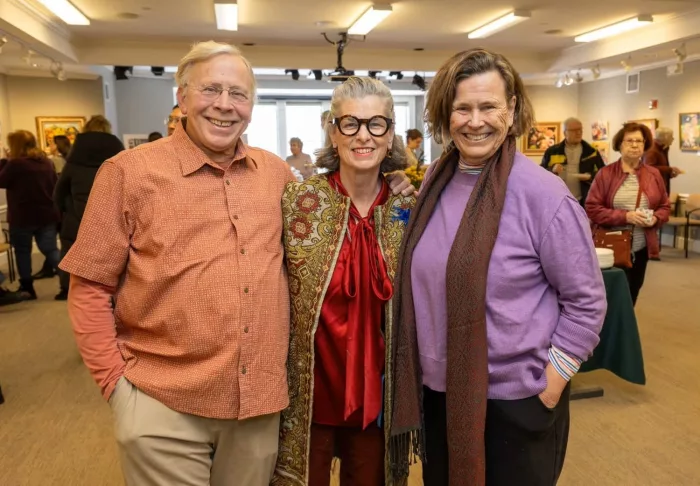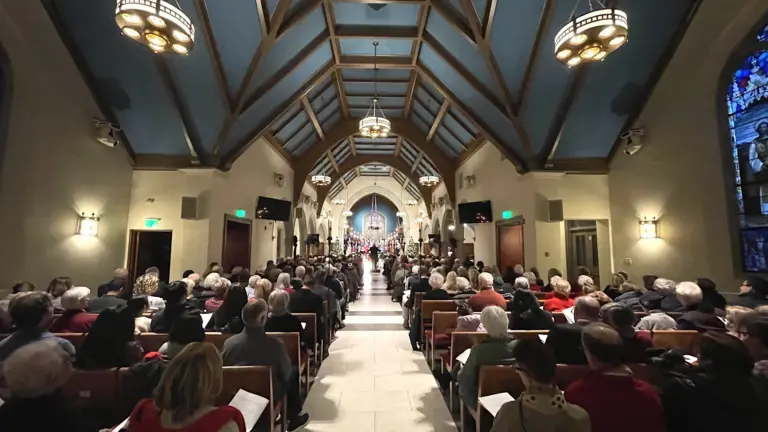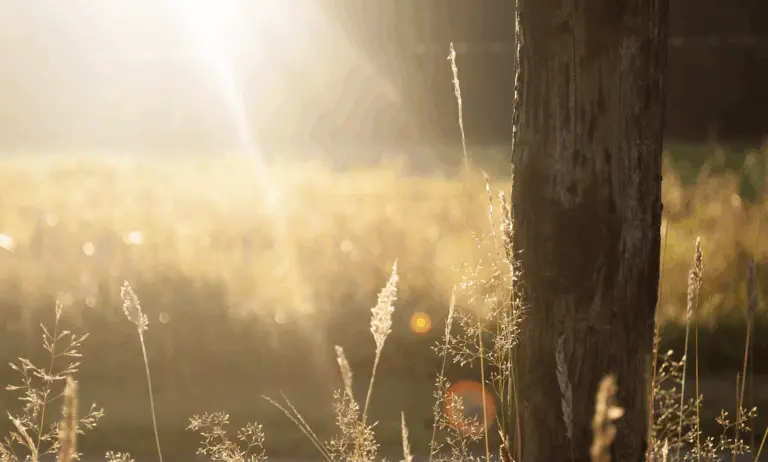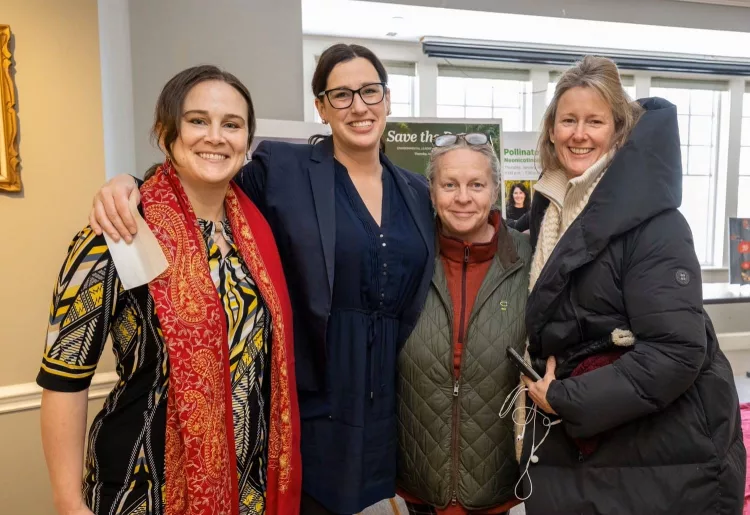
By Anne W. Semmes
Efforts to address the environment in creative and constructive ways continue to grow in the town of Greenwich. Those efforts were spelled out last Thursday at a gathering of some 120 at Greenwich Audubon featuring town leaders, an imaginative artist, and an educator of birds on their benefit to the environment. The event was the opening art exhibit of “Trash to Treasure” in the Center’s Kiernan Hall featuring artist Chris Duncan’s repurposing of thrown away art through collage. Duncan was introduced by Rochelle Thomas, executive director of the Audubon Center.
Thomas, now celebrating two years in her post, was first proud to announce the beginning renovations of the Center’s historic Mead House “so you’ll see a fresh face on John Street.” She cited Audubon Board Chair Kim Gregory for introducing her to Chris Duncan, realizing “immediately Chris was a good fit for the Center, because this show ‘Trash to Treasure’ aligns with Audubon’s mission to protect birds and their places by highlighting how all of us can contribute to reducing waste in our lives.”
Slated to address the crowd was Julie DesChamp, founder and chair of Waste Free Greenwich that Thomas described as “a grassroots nonprofit that engages, educates and empowers the Greenwich community to waste less, running solutions at home and at school through the six R’s: refuse, reuse, reduce, repair, recycle and rot. And as Julie will tell you, the reduction of waste produces innumerable downstream effects for people and birds.”
Chris Duncan described how her repurposing of artworks inspiration came to her during the Covid-19 shutdown, of “finding pieces of art that have been thrown away and then transforming them.” Per example at Goodwill, she’d found a canvas for “three bucks… I always try to get canvases that are on frames because framing is so expensive and a lot of these frames are amazing frames that actually make the artwork.” She also collects “old botanical artworks and then I just start cutting away and I start laying on top like colors.”
A resulting artwork on view was “Harvest Burst,” resplendent with two bird images included. Her modus operandi is to include birds and animals in each work.
“And it’s something that’s really fun to do with your kids,” she told. “It’s turning into something that is very different than what it was… It’s very therapeutic to cut at night while you’re sitting there watching and not watching the news.” Her aim is, “I want everybody to walk away with a smile, to find something that they didn’t think they’d find in the artwork, then you write your check [with prices marked from $150 to $350] to your favorite non-profitable. This time it’s to Greenwich Audubon because it’s a win-win…It’s really about the birds.”
Waste Free Greenwich
Waste Free Greenwich founder Julie DesChamp’s’ first message to the crowd of birders, gardeners, and environmentalists was to thank Duncan “for raising awareness about the problem of waste through her collages and for giving me the perfect excuse to talk trash with you!” Duncan’s artwork was keeping “trash” out of landfills and incinerators, “and giving it a new lease on life…She has found value in unwanted items while making a subtle statement about our culture of consumerism. Reuse is just one of the many strategies we can adopt to generate less waste on a planet.”
And why are those six R’s (refuse, reuse, reduce, repair, recycle and rot) important?
“When items are trashed,” said DesChamp, “we waste all those resources including water, energy, labor, and land used throughout the lifetime of goods from extraction and production to transport and disposal. Our trash is either burned or buried. Both have negative impacts on the environment and public health. Incineration emits toxic pollution. Incinerators and landfills are a major source of methane, a powerful greenhouse gas, and we all know trash doesn’t always make it into the bin. Litter on our street ends up in our waterways and shorelines harming birds and other wildlife.”
DesChamp encouraged preventing food waste at home. “Forty percent of food in the United States is wasted and food scraps make up about a quarter of our trash bin.” She suggested, “Shop with a list, eat leftovers, store food properly, and understand those expiration dates to prevent food waste.” And to learn more, “You can check out our website (WastefreeGreenwich.org) or attend a workshop hosted by Greenwich Audubon or Waste Free Greenwich to learn how to start your own backyard composting system.” Greenwich’s municipal food scrap recycling program, she told “has diverted over half a million pounds of wasted food to compost since 2020.”
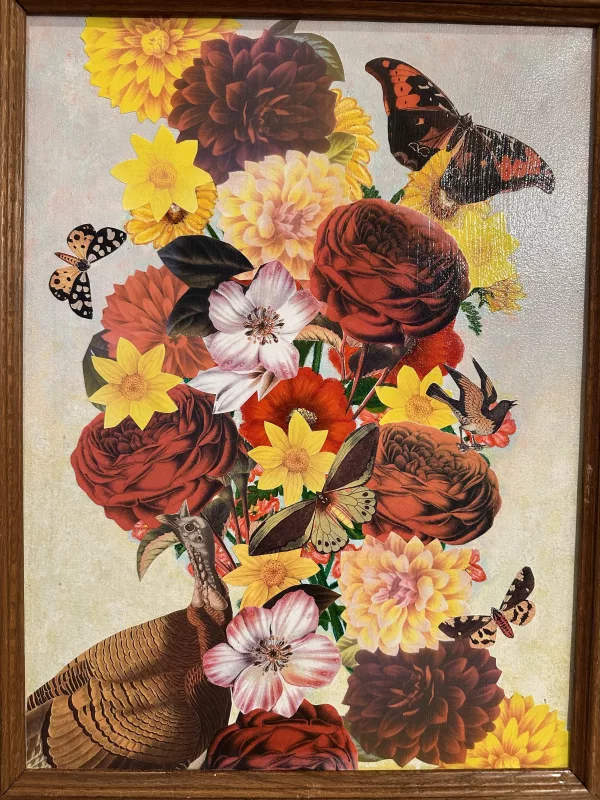
Benefiting Birds of Prey
Then it was birding time – though bird sounds of guest birds had accompanied talks – with Brian Bradley of Skyhunters in Flight. He first brought out a young Spectacled Owl before the crowd. “They may have a scholarly look on their faces,” he said, “but all the birds of prey are the most primitive minded nocturnal creatures. Think of them as instinctive, not intellectual, very reactive…They have certain tools and skills which allows them to be more effective hunters at night.” He then gave their impact on “the health of the environment.”
“They basically manage the health of the environment out there by doing two things,” he told, “They catch and eat the weak and the sick. By removing sick animals from a population, they leave the strong and healthy behind. So that allows that population to be actually healthier.” And add on, “By doing so, they also control the numbers and that’s very important as well.”
Bradley would also bring out a Barn Owl and a Great Horned Owl, all the while educating the crowd of the challenging life of these birds of prey. “What people don’t realize is that these things are as clumsy as a toddler when they’re young…fumbling around in trees and branches before they learn how to fly. It takes time and they’ve got the most difficult job in the world for that reason. When they’re out there looking around, they’re vulnerable to other predators – the first year is their most dangerous period of life. It’s said 70 to 80 percent of all young birds of prey that leave the nest every year around the world die of starvation, are eaten by other predators, or from some form of accident.”
“So, when you see a bird out there sitting up on top of a tree as you go by on 684,” he noted, “don’t take that bird for granted because that is a true survivor. That’s basically the equivalent of a gold medal Olympic athlete.”
Following on at Greenwich Audubon this Thursday will be the kickoff of the 2025 season of Pollinator Potluck meetings, featuring the growing environmental impact of neonicotinoids – the new DDT, on our pollinators and our birds.
